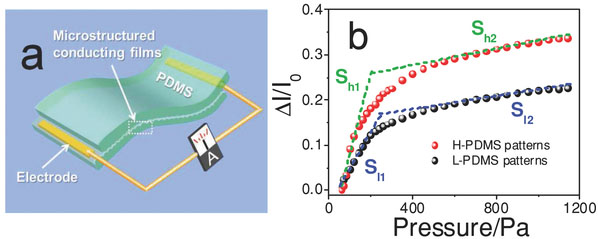文章专利

- 地址: 江苏省苏州市苏州工业园区若水路398号
- 邮箱: tzhang2009@sinano.ac.cn
- 电话: 86-512-62872706
- 传真: 0512-62603079
- 网址: http://nanosensor.sinano.ac.cn

Xuewen Wang, Yang Gu, Zuoping Xiong, Zheng Cui, and Ting Zhang*. Silk-molded Flexible, Ultrasensitive, and Highly Stable Electronic Skin for Monitoring Human Physiological Signals. Advanced Material, 2014, 26, 1336–1342.(Cover)
Monitoring human physiological signals (PS) is considered to be an effective way for disease diagnosis and health assessment. Conventional hospital-centered healthcare sensing devices including infrared based photo-electric devices and rigid multi-electrode pressure sensors have been employed for PS detection, however the use is yet rather limited because of their poor portability and wearability. Recently, flexible and stretchable artificial electronic skin (E-skin) has attracted increasing attention for its unique capability of detecting subtle pressure changes, which may open up its potential application in wearable individual-centered health monitoring, sensitive tactile information acquiring, minimally invasive surgery, and prosthetics.[1–3] Over the last few years, flexible piezoresistors, capacitors, and OFETs based on nanostructured materials including single-walled carbon nanotubes (SWNTs), Ge/ Si nanowires, and vertical ZnO nanowire arrays have demonstrated promising pressure sensing properties in low-pressure regimes (<10 kPa).[4–8] Compared to low-transparent and rigid metal/metal oxide nanowires, and conducting polymers with mechanical instability and low carrier mobilities, carbon nanotubes have been demonstrated as excellent candidates for flexible electrodes and electronics, owing to their superior mechanical flexibility and stability, great conductivity, and high transparency.[4,9] Despite great pressure sensing performance of these flexible devices, it is still a challenge to form large-scale and uniform E-skin with cost-effective fabrication methods.
Full Article:http://onlinelibrary.wiley.com/doi/10.1002/adma.201304248/full

